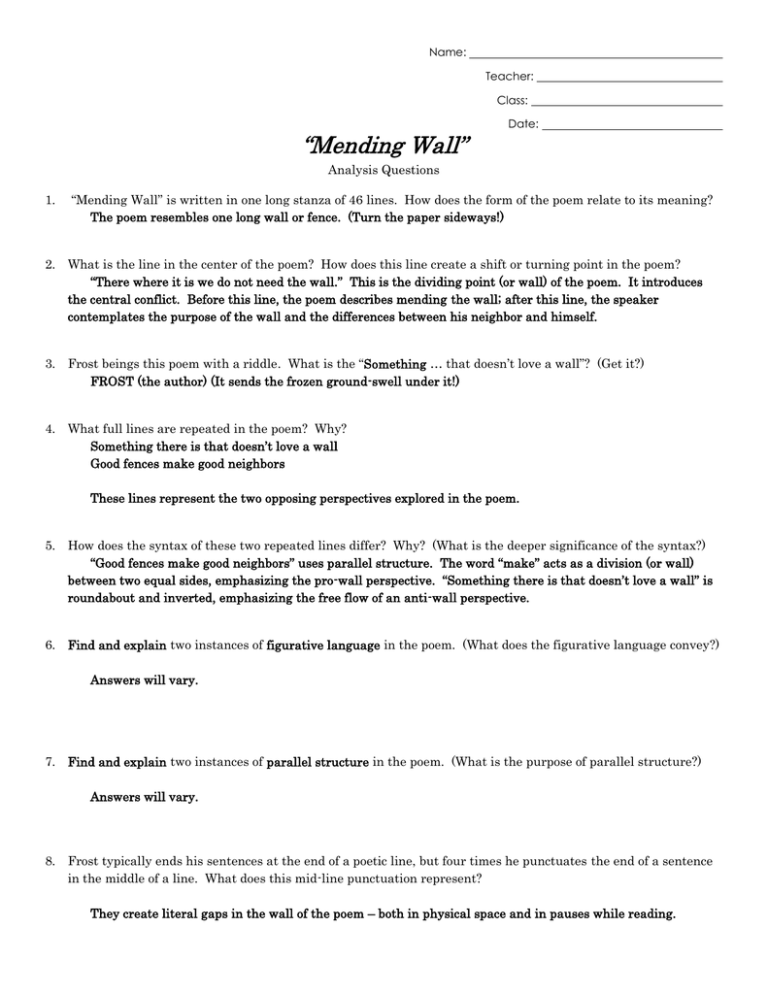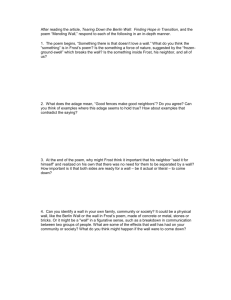"Mending Wall" Poem Analysis Questions Worksheet
advertisement

Name: Teacher: Class: “Mending Wall” Date: Analysis Questions 1. “Mending Wall” is written in one long stanza of 46 lines. How does the form of the poem relate to its meaning? The poem resembles one long wall or fence. (Turn the paper sideways!) 2. What is the line in the center of the poem? How does this line create a shift or turning point in the poem? “There where it is we do not need the wall.” This is the dividing point (or wall) of the poem. It introduces the central conflict. Before this line, the poem describes mending the wall; after this line, the speaker contemplates the purpose of the wall and the differences between his neighbor and himself. 3. Frost beings this poem with a riddle. What is the “Something … that doesn’t love a wall”? (Get it?) FROST (the author) (It sends the frozen ground-swell under it!) 4. What full lines are repeated in the poem? Why? Something there is that doesn’t love a wall Good fences make good neighbors These lines represent the two opposing perspectives explored in the poem. 5. How does the syntax of these two repeated lines differ? Why? (What is the deeper significance of the syntax?) “Good fences make good neighbors” uses parallel structure. The word “make” acts as a division (or wall) between two equal sides, emphasizing the pro-wall perspective. “Something there is that doesn’t love a wall” is roundabout and inverted, emphasizing the free flow of an anti-wall perspective. 6. Find and explain two instances of figurative language in the poem. (What does the figurative language convey?) Answers will vary. 7. Find and explain two instances of parallel structure in the poem. (What is the purpose of parallel structure?) Answers will vary. 8. Frost typically ends his sentences at the end of a poetic line, but four times he punctuates the end of a sentence in the middle of a line. What does this mid-line punctuation represent? They create literal gaps in the wall of the poem – both in physical space and in pauses while reading. 9. “Mending Wall” is written in iambic pentameter, with 10 syllables in each line. Which lines have more than 10 syllables? How does the meaning of the line relate to the extra syllable? (Find and explain at least 3 lines!) Answers will vary. There are 11 lines with 11 syllables. a. “But they would have the rabbit out of hiding” – The extra syllable is forced out, like the rabbit b. “To each the boulders that have fallen to each” – The extra syllable falls off, like the boulders c. “We have to use a spell to make them balance” – The extra syllable emphasizes the imbalance d. “He is all pine and I am apple orchard” – The extra syllable emphasizes differences 10. What words and phrases suggest something mysterious or magical about the destruction of the wall? (at least 3) What is the message Frost sends by including these images and allusions? “Something there is …” “No one has seen them made or heard them made” “We have to use a spell to make them balance” “My apple trees will never get across…” “‘Elves’” The wall is unnatural – nature and the supernatural both want the wall destroyed. 11. What words and phrases suggest recreation and amusement? (Find at least 3 examples!) What is the tone Frost sets by including these images and allusions? “Something there is …” “they would have the rabbit out of hiding” “We keep the wall between us as we go” “To each the boulders that have fallen to each” “just another kind of outdoor game” “Spring is the mischief in me” The playful tone emphasizes how enjoyable the wall mending can be 12. What does the narrator say he would want to know before building a wall? (Get it?) to whom he is like to give offense (A FENCE) 13. What is the significance of the neighbor’s determination to “not go behind his father’s saying”? His father’s saying is a boundary he is not willing to cross. It is a figurative wall separating him from the speaker. 14. Find and explain an instance of irony in the poem. Answers will vary. 15. Other than the wall they are mending, what walls stand between the speaker and his neighbor? Answers will vary.






